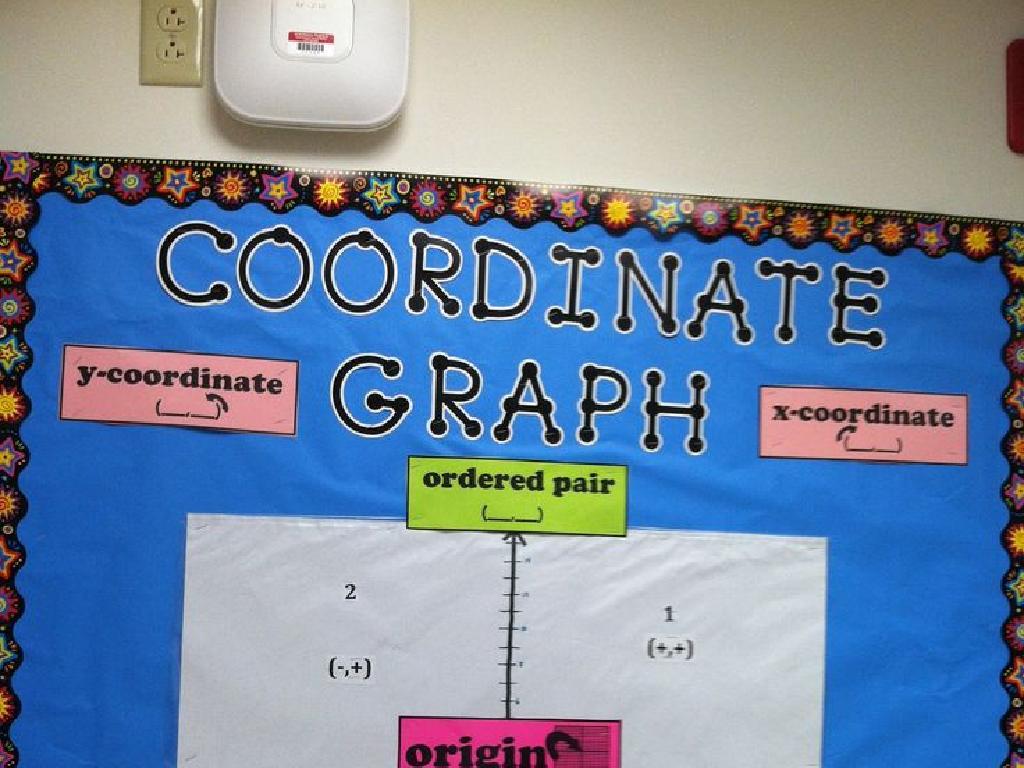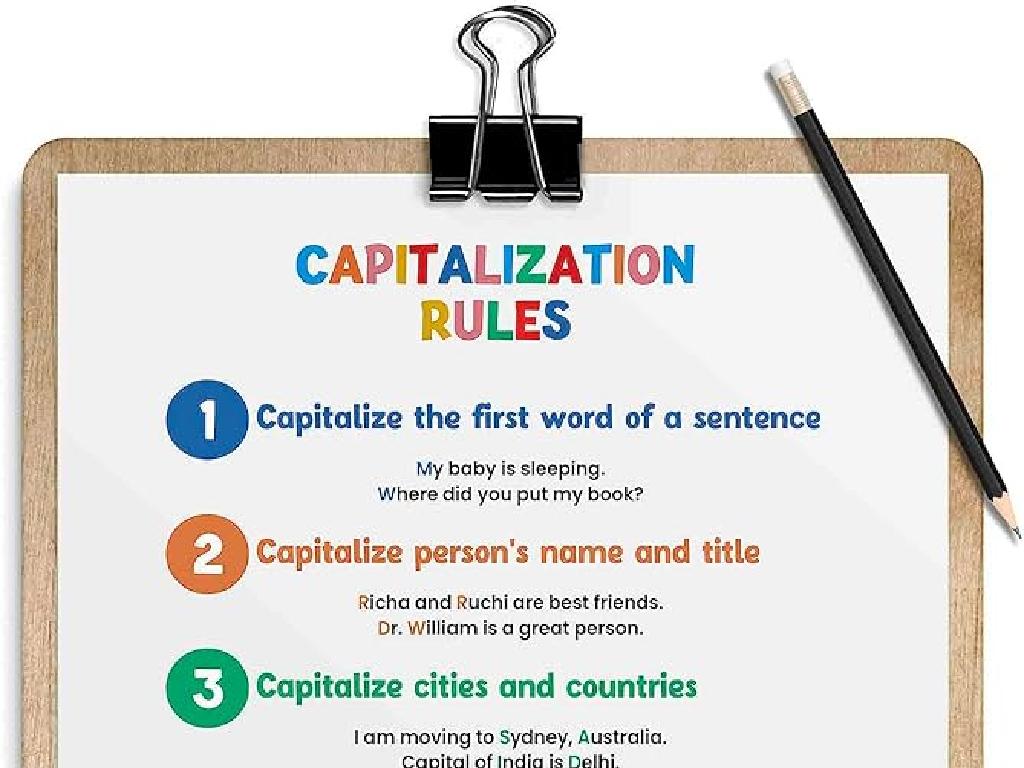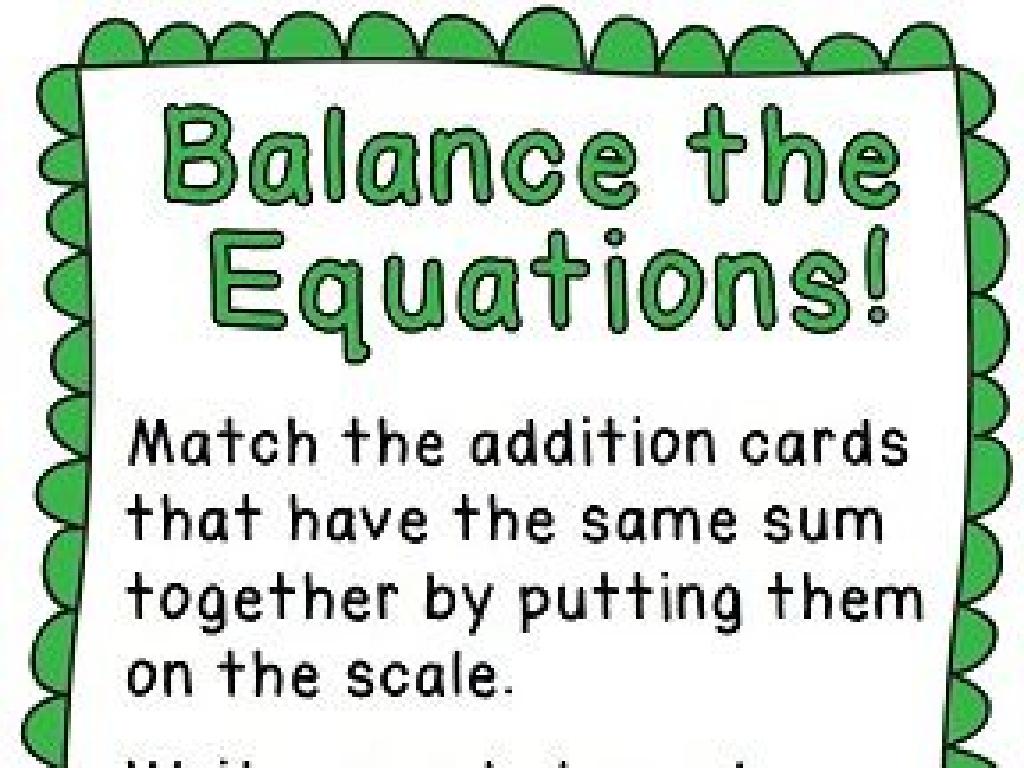Solve The Proportion
Subject: Math
Grade: Sixth grade
Topic: Ratios And Rates
Please LOG IN to download the presentation. Access is available to registered users only.
View More Content
Introduction to Proportions
– Understanding ratios and rates
– Ratios compare two quantities, rates compare per unit time or measure
– Defining a proportion
– A proportion states two ratios are equal
– Proportions in real life
– Recipes, maps, and model building use proportions
– Solving proportion problems
– Use cross-multiplication to find the missing number
|
Begin the lesson by explaining the concept of ratios and rates, ensuring students grasp how they compare different quantities. Then, introduce the definition of a proportion as an equation that shows two ratios are equivalent. Provide real-life examples where proportions are used, such as in cooking to adjust recipes, in reading maps, or in building models to scale. Finally, demonstrate solving proportions by cross-multiplication, which is a method to find an unknown value in a proportion. Encourage students to practice with examples and prepare a few problems for them to solve as a class activity.
Understanding Ratios: Foundations for Proportions
– Recap on what ratios are
– Ratios compare two quantities, like 2 apples for every 3 oranges.
– Ratios in daily life
– Common examples: recipes, maps, or mixing paints.
– Simplifying ratios
– Divide both terms by their greatest common divisor.
– Importance of simplest form
– Simplest form makes ratios easier to work with and understand.
|
Begin with a brief review of ratios, ensuring students recall that ratios are comparisons between two quantities. Use relatable examples such as recipes (2 cups of flour to 3 cups of sugar), maps (1 inch represents 10 miles), or mixing paints (1 part blue to 2 parts yellow) to illustrate ratios in everyday life. Teach students how to simplify ratios by finding the greatest common divisor and dividing both terms to achieve the simplest form. Emphasize that working with ratios in their simplest form is crucial for solving proportions accurately and efficiently. Encourage students to practice simplifying ratios with classroom activities and homework assignments.
What Makes Proportions
– Definition of a proportion
– A proportion is an equation stating two ratios are equal.
– Identifying proportions
– Look for two ratios that share a relationship.
– Understanding equivalent ratios
– Ratios that have the same value when simplified.
– Solving proportions in steps
– Use cross-multiplication to find the missing number.
|
Begin by explaining that a proportion is simply an equation where two ratios are equal. Emphasize that identifying proportions involves recognizing when two ratios represent the same relationship or share the same value when simplified. Use examples like 1/2 is to 2/4 as 3/6 is to 6/12 to illustrate equivalent ratios. Teach the students the cross-multiplication method to solve for unknown variables in proportions. Provide practice problems where students can apply these concepts to reinforce learning. Encourage students to explain their reasoning when solving proportions to deepen their understanding.
Solving Proportions with Cross Multiplication
– Understand cross multiplication
– Cross multiply to find the unknown in a proportion: a/b = c/d becomes ad = bc
– Solve a simple proportion example
– Example: If 4/5 = x/10, then 5x = 40. What is x?
– Learn to check the solution
– Substitute the solution back into the original proportion to verify
– Practice with different problems
|
This slide introduces the concept of solving proportions using the cross multiplication method. Start by explaining that cross multiplication is a technique used to find the unknown variable in a proportion, where two ratios are equal. Provide a simple example, such as 4/5 = x/10, and demonstrate how to cross multiply to solve for x. Emphasize the importance of checking the solution by substituting it back into the original proportion to ensure it makes both sides equal. Encourage students to practice this method with different problems to gain confidence in solving proportions.
Proportions in Real Life
– Proportions in cooking recipes
– Adjust ingredients for more or fewer servings using ratios.
– Map reading with proportions
– Use scale to understand real distances between locations.
– Art and design proportions
– Apply ratios to maintain design consistency and balance.
|
This slide aims to show students how proportions are used in everyday life. When cooking, proportions are essential for adjusting recipes depending on the number of servings needed. In map reading, understanding the scale as a proportion helps in estimating real-life distances. In art and design, proportions are crucial for creating visually appealing and balanced works. Encourage students to think of other areas where they might use proportions and to bring examples to the next class. This will help them see the practical applications of what they learn in math class.
Proportion Solving Practice
– Solve the given proportions
– Create your own proportions
– Think of real-life ratios to frame your proportions
– Exchange problems with a peer
– Review each other’s solutions
– Give constructive feedback on your peer’s work
|
This slide is designed to engage students in active practice of solving proportions. Start with a set of prepared proportion problems for the students to solve, ensuring a variety of difficulty levels. Encourage students to create their own proportions, possibly relating them to real-life scenarios to make the activity more engaging. Organize a peer exchange where students swap their created problems with each other, which promotes collaboration and communication skills. Finally, have them review and provide feedback on the solutions to their original problems. This activity will help reinforce their understanding of proportions and their ability to apply the concept in different contexts. Provide guidance on how to give constructive feedback and encourage a supportive learning environment.
Class Activity: Proportion Scavenger Hunt
– Find proportions in the classroom
– Work in pairs for the hunt
– Solve the discovered proportions
Use methods like cross-multiplication to solve.
– Share findings with the class
|
This interactive activity is designed to help students apply their knowledge of proportions in a fun and engaging way. Set up various proportion problems around the classroom beforehand. Students will work in pairs to find and solve these proportions, encouraging collaboration and problem-solving skills. After the scavenger hunt, each pair will present their solutions and explain how they solved the proportions. This will reinforce their understanding and allow them to learn from each other. Possible variations of the activity could include a timed challenge, incorporating word problems, or using real-life objects to create the proportions.
Wrapping Up: Proportions
– Review of proportion concepts
– Significance of mastering proportions
– Proportions are vital in math and real-life applications.
– Homework: Practice problems
– Solve 10 proportion problems to reinforce today’s lesson.
– Next class: Further exploration
– We’ll delve deeper into complex proportion problems.
|
As we conclude today’s lesson on proportions, it’s crucial to recap the key concepts and methods we’ve learned for solving proportions. Emphasize the importance of understanding proportions as they are foundational for many mathematical concepts and real-world problem solving, such as cooking, construction, and science. For homework, students are assigned 10 problems to practice solving proportions, which will help solidify their grasp of the topic. In the next class, we will continue to build on this knowledge by tackling more complex proportion problems. Encourage students to approach their homework with the same strategies discussed in class and to reach out if they encounter any difficulties.






